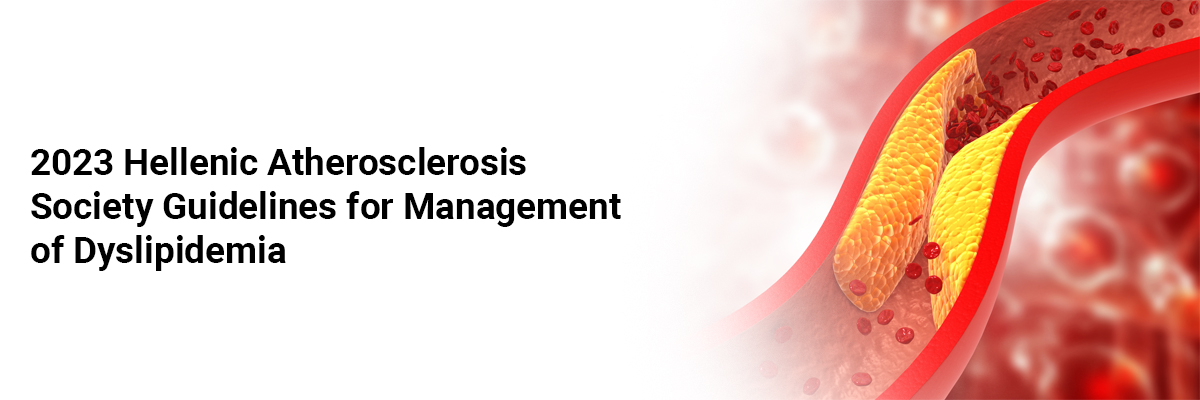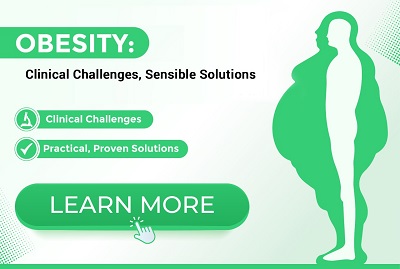
2023 Hellenic Atherosclerosis Society Guidelines for Management of Dyslipidemia
Atherosclerotic cardiovascular disease (ASCVD) is the leading cause of mortality globally, and dyslipidemia is considered as a significant risk factor for the development of ASCVD. Hence, prompt diagnosis and appropriate management of dyslipidemia plays a critical role in the prevention and treatment of ASCVD. The 2023 guidelines from the Hellenic Atherosclerosis Society emphasize the evaluation of risk factors of ASCVD along with the diagnosis and treatment of lipid disorders in specific populations, including women, the elderly, and patients with heart failure (HF) and chronic kidney disease (CKD).
Risk factors associated with ASVCD
Very high ASCVD risk includes:
- Established coronary heart disease (CHD)
- Ischemic stroke/ transient ischemic attack
- Peripheral arterial disease
- Atherosclerotic arterial stenosis >50%
- Abdominal aortic aneurysm
- Familial hypercholesterolemia with ≥1 major risk factor
- Diabetes type 2 with target organ damage or ≥3 major risk factors (age, smoking, atherogenic dyslipidemia, hypertension, obesity) or diabetes type 1 > 20 years duration
- CKD stage 4 (eGFR <30 mL/min/1.73 m2).
High ASCVD risk group includes:
- At least one severe risk factor {stage 3 hypertension, extreme smoking, low-density lipoprotein cholesterol (LDL-C)>190 mg/dL}
- Familial hypercholesterolemia without any major risk factor
- Diabetes >10 years duration with 1–2 major risk factors (age, smoking, atherogenic dyslipidemia, hypertension, obesity)
- CKD stage 3 (eGFR 30–60 mL/min/1.73 m2)
- Autoimmune diseases/HIV infection.
Moderate ASCVD risk group includes:
Diabetes <10 years duration in persons <45 years (type 2) or <35 years (type 1) without any major risk factors.
Management of dyslipidemia in patients with chronic kidney disease
- • In order to diagnosis secondary causes of dyslipidaemia and hypertriglyceridemia, a fasting lipid profile should be conducted to evaluate the need for initiation of lipid-lowering treatment in all CKD patients.
- LDL-C reduction of ≥50% from baseline and an LDL-C goal <70 mg/dL (1.8 mmol/L) should be achieved in high-risk stage 3 CKD patients.
- LDL-C reduction of ≥50% from baseline and an LDL-C goal <55 mg/dL (1.4 mmol/L) should be achieved in very high-risk stage 4–5 CKD patients.
- Statin with or without ezetimibe therapy (usually given for patients who do not achieve LDL-C targets or have statin intolerance) has been shown remarkable outcomes by reducing major cardiovascular events in CKD patients.
- Statins not only have the potential to reduce microalbuminuria and proteinuria, but they can also be used for the prevention of contrast-induced acute kidney injury.
- Dose adjustments, based on the statins used, concomitant drugs (e.g., cyclosporin) and eGFR, are required in patients with CKD. Atorvastatin does not require dose adjustments as this drug is cleared exclusively by the liver in comparison to rosuvastatin as it needs both liver and kidney clearance. Moreover, fenofibrate should be used cautiously in CKD patients, as it can cause transient increase in the serum creatinine levels.
Management of dyslipidemia in heart failure
- Statins can render benefits by decreasing the risk of ASCVD in patients with less advanced HF, whereas the progressive loss of pump function might reduce any potential benefits from statin therapy in patients with severe HF.
- Statins can reduce the incidence of HF in patients with stable CHD without previous HF.
- In advanced stages of HF with severe cachexia, the continuation of statin therapy may need to be reconsidered as part of a palliative care.
- Statin initiation is usually not a choice of treatment except for patients already receiving a statin for coronary heart disease.
- There is a dearth of data demonstrating the use of ezetimibe in HF patients.
Management of dyslipidemia in women
- Statin is considered as the cornerstone for prevention of primary ASCVD in women at high-risk.
- Complications associated with pregnancy such as preeclampsia, eclampsia, gestational diabetes, and menopause are considered as risk-augmenting factors.
- Lipid lowering agents are not recommended to a woman who is trying to conceive, during pregnancy and breastfeeding.
- US FDA has advised to remove the contraindication of statin use in all pregnant patients as the benefits of statins outweighs its side effects, which include prevention of adverse or potentially fatal events in a small group of very high-risk pregnant patients, particularly in patients with homozygous familial hypercholesterolemia and those who have previously had a heart attack or stroke.
Management of dyslipidemia in elderly
- In light of the presence of comorbidities (especially decreased renal function) and polypharmacy, it is recommended to use statins with least risks for interactions with other treatments (e.g., rosuvastatin) and minimal renal clearance (e.g., atorvastatin and pitavastatin) in the elderly.
- Statin therapy should be initiated at a low dose and then titrated upwards to achieve desired LDL-C to prevent renal impairment and/or drug interactions.
- Lipid-lowering therapy must be targeted at achieving LDL-C levels <55, <70 and < 100 mg/dL in very high, high, and moderate risk elderly patients (≤75 years old).
- A reduction of baseline LDL-C levels by >50% is recommended in very high- and high-risk elderly patients (≤75 years old).
- Statin therapy should be administered in very high- and high-risk elderly patients >75 years old.
Source: Katsiki N, Filippatos T, Vlachopoulos C, Panagiotakos D, Milionis H, Tselepis A, Garoufi A, Rallidis L, Richter D, Nomikos T, Kolovou G, Kypreos K, Chrysohoou C, Tziomalos K, Skoumas I, Koutagiar I, Attilakos A, Papagianni M, Boutari C, Kotsis V, Pitsavos C, Elisaf M, Tsioufis K, Liberopoulos E. Executive summary of the Hellenic Atherosclerosis Society guidelines for the diagnosis and treatment of dyslipidemias - 2023. Atheroscler Plus. 2024 Feb 17;55:74-92. doi: 10.1016/j.athplu.2024.01.004. PMID: 38425675; PMCID: PMC10901915.













Please login to comment on this article